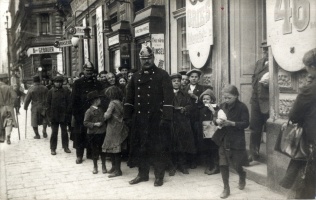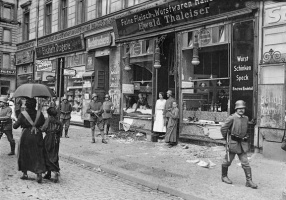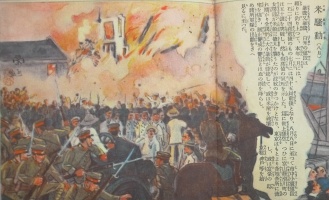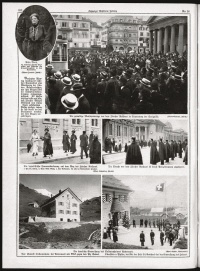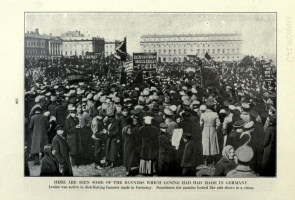Introduction↑
While at the beginning of the war belligerent societies demonstrated social cohesion by being able to mobilize their populations, the last years were marked by growing social conflict. Civilians everywhere accepted sacrifices for the war effort up to a certain point, but felt increasingly entitled to make demands from the state. The length of the war weakened overall support. Social distinctions were sharpened by the experience of food shortages on the home front and material hardship provoked social movements and riots all over the world. Earlier historiography of social conflict focused on its revolutionary potential and the influence of the Bolshevik model on other countries. Since the 1990s, however, new approaches have broadened the scope of analysis to include different forms of street protests beyond strikes and actions in the labour movement. This new historiography has shown the political content of demands linked to economic conditions. This article offers an overview of the main characteristics of social conflict on a global scale. It does not provide a detailed description of individual events, but rather reflects on the similar features of social conflict during and immediately after the First World War in different locations: disruption of social relations, expectations of equal rewards for sacrifice, and the undermining of state legitimacy.
The Social Relations of Sacrifice↑
Across belligerent societies, as the war dragged on, ordinary families on the home front increasingly suffered from the growing number of military casualties and the scarcity of common goods. A language of sacrifice framed in moral terms characterized the discourse on the war among civilian populations. This community of sacrifice could solidify bonds among a nation but it also clearly excluded those who did not participate: the “shirkers” avoiding military service and the “profiteers” taking economic advantage of wartime suffering.[1] Variations of the “profiteer” (profiteur in French, Wucherer or Kriegsgewinnler in German, narikin in Japanese) surface as a figure of hate in wartime popular discourse around the world. Jean-Louis Robert has shown that the image of the profiteer in English, French, and German caricatures was diametrically opposed to that of the soldier. The “profiteer” highlighted norms of unacceptable behaviour in wartime: this could range from the grocer who refused to sell his goods to the industrialists who made large profits.[2] The condition of acceptance of wartime hardship was its equal distribution among the population.
And yet the conflict’s economic consequences of increased inflation, falling living standards, and housing shortages meant that social distinctions acquired a heightened significance. Shortages of food and fuel concerned all the belligerents (and even neutral countries) to a certain degree but the situation was critical earlier and the penury more substantial in the Central Powers (including the Ottoman Empire) and in Russia than in France or Britain. The worsened material conditions sharpened old social divisions and created new ones. Everywhere it was easier for the rich to obtain food despite rationing, which fed resentment against the comparatively better-off. In England, the working-class felt disproportionately affected by unequal distribution and food queues in the winter of 1917 and 1918.[3] In other societies, the urban-rural antagonism acquired particular currency as farmers were accused of hoarding supplies and leaving city-dwellers to starve.[4] In Central and Eastern Europe, the discourse against profiteers often targeted Jews and turned into virulent antisemitism, for example in Warsaw.[5] The growing numbers of refugees in many cities of the hinterland also generated competition with local populations for dwindling food supplies and resentment against newcomers. As Maureen Healy has shown in the case of Vienna, access to food determined new social hierarchies.[6] Middle-class people and employees on fixed incomes were particularly hit hard by the changing economic conditions. They experienced their struggles to obtain basic consumption goods as a loss of social status. All these divisions furthered social disintegration and created a climate where anger could find its expression in the streets.
Food Riots and Moral Economy↑
The long queues to obtain food, which had become a daily experience for many civilians, could easily turn to rioting if consumers were left empty-handed. Food or subsistence riots on a larger or smaller scale occurred in every belligerent country during the First World War and even in neutral states. More significant and violent riots took place in Russia as early as 1915,[7] while Vienna and Berlin saw the first small protests during that year but more frequent and serious unrest from 1917 onwards. Violent movements erupted in many cities as far as New York, Melbourne, and Lisbon in response to increased food prices in 1917.[8] The prevalence of food riots in the last two years of the war has led historians to borrow frameworks of interpretation from early modern historians, especially E. P. Thompson and his notion of “moral economy”.[9] Thompson showed that rioters in 18th century England did not necessarily respond to a situation of objective penury but rather to a perceived unfairness in food distribution. Similarly, many of the food riots during the last two years of the conflict articulated a discourse about rights in wartime and what was expected in return for the population’s sacrifices. The notion that justice, rather than simply food, was at stake animated many of the riots. In Melbourne in 1917, the protestors chanted: “we want food and fair play”.[10] This language was also visible in other forms of protests like the Glasgow rent strikes of 1915 against landlords raising rents while men were fighting. In a speech at the Glasgow Women’s Housing Association, a speaker explained that women were asking “not for money, not for charity, they were asking for justice”.[11] Adam Seipp who compared social conflicts in Manchester and Munich interprets them as stemming from a “crisis of reciprocity”, where the state was perceived as failing in rewarding wartime sacrifice.[12]
Wartime social movements took different forms, incorporating varying levels of violence and targeting either state institutions or shop owners. On the whole, less violent confrontations often correspond to contexts where the shortages were less severe: studies of Russian riots show violence against state agents earlier on while relatively peaceful negotiations on food issues prevailed in Britain, one of the best fed belligerent countries during the war.[13] However, the nature of social conflict within a state was not monolithic and changed with the course of the war. A more detailed analysis of all these movements at the national scale is necessary to perceive the differences between regions and the evolution as the war progressed. Even within the same country, protests regularly displayed different strategies concomitantly. Japan in the summer of 1918, for example, experienced numerous rice riots, a series of mass demonstrations, which were unprecedented in the country. Incidents included nonviolent sit-ins, attacks on grain brokers and merchants, destruction of rice, forcing price retailers to sell at a fair price, and urban mass rallies in cities like Nagoya attended by 40,000 to 50,000 people.[14] Many of the earlier demonstrations in individual countries or cities took the form of pleas to the relevant authorities. The more direct plunder of shops or violent attacks often occurred at a later stage in the development of the riot movement. Crowds sometimes moved from one locale to another to demonstrate, loot, or throw stones at shop windows, as Maureen Healy describes in the case of Vienna.[15]
Historians of gender have been pioneers in the study of these forms of 20th century food riots, underlining their political dimension. Many of the participants of these riots were indeed women, who were often in charge of buying food for the whole household and could thus be more sensitive to consumers’ issues. Earlier historiography analysed these riots in terms of an emerging “female consciousness” for participants, as Temma Kaplan did for Barcelona.[16] Belinda Davis also argued that women gained political agency through food riots in Berlin and that their protests paved the way for the revolution at the end of the war.[17] This historiography interpreted 20th century food riots as a specifically female form of action, arguing that the gendered division of labour meant that food had become primarily women’s responsibility while increased politicisation gave men other avenues to express grievances.[18] However, more recent studies tend to underline that the participants in these riots could be more mixed without fundamentally transforming their mode of operation. In occupied Belgium, for example, both men and women took part in food riots.[19] In Japan, women also did not usually take the role of crowd organizers. A more nuanced understanding of the role played by gender in First World War protests is thus required. Women might have been mostly in charge of food purchases in the pre-war period but the hunger crisis meant that food became an issue for men as well in the more extreme contexts of shortages (Central Powers, Russia, occupied territories). Even in England, where the situation was less dramatic, the war rather lessened the relevance of gendered language around consumer issues.[20] Antoon Vrints argues that the limits on regular political life in Belgium encouraged men’s participation in riots. This observation could be extended to many belligerent countries where governments imposed restrictions on political rights.
Local Movements on a Global Scale↑
There is hardly a European country that did not experience some form of food riot between 1917 and 1920 (even neutral countries such as the Netherlands, Spain, and Switzerland did); comparable protests also took place beyond the continent in Melbourne, New York, and Japan. The similarity across the globe of demands for better supply and fairer allocation is striking. The numerous food riots during the First World War have been mostly studied by historians as local phenomena in a particular city. Their chronology does not necessarily correspond to specific events or turning points on the battlefield or even revolutions abroad but rather respond to very local conditions (for example the sudden unavailability of a food product). Their dynamics are best understood through the prism of local concerns. Social conflict during the war was particularly prevalent in urban settings and in larger cities as they were both more vulnerable to food shortages (and shortages of fuel and housing) and concentrated major seats of local or national power.[21] Riots and strikes were also not uniformly present within the same country. In Italy, for example, protests concentrated in certain regions: in the north of the country (especially in Milan and Turin), in Tuscany, and in a few Southern regions.[22]
Their recurrence in so many very different societies and on a massive scale challenges the notion that food riots were by the early 20th century an outdated form of social conflict, a remnant of preindustrial forms of collective action. Charles Tilly’s sociohistorical model, arguing that local protests had become less relevant with the strengthening of the central state and that new forms of collective action such as strikes had progressively replaced food riots from the mid-19th century, does not account for the significance (both in number and scope) of wartime riots.[23] The nature of First World War unrest thus questions long-held assumptions about the evolution of social conflict in the modern era. Looking at this wave of individual protests and demonstrations together enables them to be seen as an inherent part of the developing relationship between state and society in wartime.
Traditional labour history has examined the strike wave of 1917-1918 relatively in isolation from other forms of protest and as the most significant event among them. However, strikes do not encompass the whole spectrum of social conflict at the time. Food riots and industrial action were often directly linked: strikes could be accompanied by demonstrations and turn to riots as they did in Turin in August 1917, one of the most violent insurrections in wartime (several deaths and hundreds of wounded in the repression). The unrest was directly rooted in bread shortages and demands for better supply. Food protests could also generate a strike movement as was the case in Petrograd in February 1917. In other major strikes of the period like the Austrian strikes of January 1918, falling living standards were the cause of the stoppages, which then led to mass demonstrations. The distinction between strikes as a men’s movement and subsistence riots as a women’s mode of action thus does not always reflect the blurry distinctions between the two in wartime, as the case of the midinettes strikes in Paris in 1917 shows.[24]
Messages of war-weariness, and the growing dissatisfaction with a war without end were also present in many of these protests. The role played by anti-war messages in demonstrations depends on the region and the level of dissatisfaction with the state as well as the existence of pre-existing tensions in the society. In Britain, for example, where support for the war effort remained comparatively more consensual until the end, strikes stopped in April 1918 when the situation at the front looked dangerous.[25] Conversely, opposition to the war surfaced earlier in protests against conscription, which sometimes had a social dimension. For example, the large rebellions in Central Asia in 1916 against military draft had more profound roots in structural economic and social imbalances.[26] Similar anti-colonial revolts occurred on a smaller scale in Algeria in 1916.[27] Questions around recruitment and mobilization fuelled conflicts and tensions around the support for the war effort, as states drew on more and more human and material resources.
Historians have shown that the social conflict of the last two war years played an important role in understanding regime change in 1918. Food riots directed against state authorities expressed the clear expectation that the state would provide basic food supply while the inability to offer clear solutions undermined state legitimacy. It is important to underline the internal dynamics of these protests where progressive exhaustion of legal means of complaint provoked a gradual radicalization and a higher recourse to violence. In Germany, “self-help” became a motto at the end of the war and during the revolutionary phase. The impression of inefficient management from the authorities encouraged protesters to take matters into their own hands.[28] Even in countries where the regime did not collapse, the war generated a reconfiguration of the relationships between citizens and their state and a stronger entitlement to political participation. The consumer demonstrations in Paris in 1919 offered, for instance, an alternative model of consumer citizenship where working-class influence on the price of basic goods was considered key.[29]
Social Protest after the War↑
The immediate aftermath of the war did not end the cycle of street protests and in many countries the first post-war years saw a resurgence of social conflict. The continuity between wartime and post-war unrest is visible in the similarity of their aims and demands. Many of the wartime grievances were indeed not resolved after the official end of hostilities. The demobilization and return of soldiers brought new actors in the protests who felt they could make claims on a state for which they had fought. In East Central Europe and the Middle East, the armistice did not mark the conclusion of a cycle of violence, which spilled over into smaller conflicts.[30] Riots, strikes, and demonstrations marked the stabilization phases of virtually all the new regimes established after the fall of empires in Europe. In many places, the instability generated by the creation of new states created new aspirations for social justice and control of state institutions. Political agitation was further radicalized by the rise of violent right-wing movements, which exacerbated social conflict.[31] In Germany, the unrest of the last year of the war continued in 1919 and 1920.[32] Post-war social conflict also affected rural areas in the form of protests for land reform, especially in Italy and in East Central Europe. In Italy, the “biennio rosso” marked a new wave of strikes and demonstrations, especially in June 1919 against food shortages.[33] In France, 1919 appears as a major year for social conflict with massive strikes among metallurgy workers, and protests against high prices in Paris, Le Havre, Brest, and Rouen.[34] As Roberto Bianchi has shown, all these post-war movements did not just constitute a reactivation of old modes of protest or signal failed revolutions but were a genuinely unique moment of social mobilization that coincided with reformulations of the relationship between states and their citizens.[35]
1919 also represented a watershed moment for anti-colonial movements. The wave of unrest in the wake of the war expressed a galvanized nationalism and a reaction to the Paris Peace Treaties, though many of the revolts of 1919 also had a social component. In Egypt, the peasant revolts of March 1919 were shaped by concerns around food supply and equal distribution of entitlements after years of wartime requisitions.[36] In India as well, social conflict played a role in the revolts of that year as the country attempted to redefine its relationship to the central state.[37]
Conclusion↑
The numerous riots, strikes, demonstrations, and revolts from 1917 to 1920 correspond in many countries to one of the peaks in popular mobilization during the 20th century. These movements all have their particular causes in local settings but the war created everywhere the conditions for renewed social conflict. The food shortages that were present in every society at various degrees of severity conditioned new social relations while direct or indirect participation in the war generated new expectations for the fulfilment of social demands. Citizens’ relationship to their state, which was already changing by the early 20th century, was at the heart of many of these protests. The global movement of revolutionary upheavals in the wake of the conflict thus integrated many of the internal conflicts born from the strains imposed on societies at war.
Claire Morelon, University of Padova
Section Editor: Michael Geyer
Notes
- ↑ Horne, John: Public Opinion and Politics, in: Horne, John (ed.): A Companion to World War I, Chichester 2010, p. 283. On “shirkers” in France see: Ridel, Charles: Les Embusqués, Paris 2007.
- ↑ Robert, Jean-Louis: The image of the profiteer, in: Robert, Jean-Louis / Winter, Jay (eds.): Capital cities at war. Paris, London, Berlin 1914–1919, Cambridge 1997, pp. 104-132.
- ↑ Waites, Bernard: A Class Society at War: England, 1914-1918, London 1987, p. 224.
- ↑ Morelon, Claire: A threat to national unity?: the urban-rural antagonism in Prague during the First World War in a comparative perspective, in: Dornik, Wolfram / Walleczeck, Julia / Wedrac, Stefan (eds.): Frontwechsel: Österreich-Ungarns “Grosser Krieg” im Vergleich, Vienna 2014, pp. 325-342.
- ↑ Blobaum, Robert: A Minor Apocalypse: Warsaw During the First World War, Ithaca 2017.
- ↑ Healy, Maureen: Vienna and the Fall of the Habsburg Empire: Total War and Everyday Life in World War I, Cambridge 2004, pp. 43-73.
- ↑ Engel, Barbara Alpern: Not by Bread Alone. Subsistence Riots in Russia during World War I, in: The Journal of Modern History 69/4 (1997), pp. 696-721.
- ↑ Frank, Dana: Housewives, Socialists, and the Politics of Food: The 1917 New York Cost-of-Living Protests, in: Feminist Studies 11/2 (1985), pp. 255-285.
- ↑ Thompson, E.P.: The Moral Economy of the English Crowd in the Eighteenth Century, in: Past & Present 50 (1971), pp. 76-136.
- ↑ Smart, Judith: Feminists, Food and the Fair Price. The Cost of Living Demonstrations in Melbourne August-September 1917, in: Labour History 50 (May 1986), p. 119.
- ↑ Melling, Joseph: Rent strikes. Peoples’ struggles for housing in West Scotland 1890-1916, Edinburgh 1983, p. 92.
- ↑ Seipp, Adam R.: The Ordeal of Peace. Demobilisation and the Urban Experience in Britain and Germany, 1917-1921, Farnham 2009.
- ↑ Engel, Not by Bread Alone 1997; Hunt, Karen: The Politics of Food and Women’s Neighborhood Activism in First World War Britain, in: International Labor and Working-Class History 77 (2010), pp. 8-26.
- ↑ Lewis, Michael Lawrence: Rioters and Citizens. Mass Protest in Imperial Japan, Berkeley 1990, pp. xvii, 16.
- ↑ Healy, Vienna and the Fall of the Habsburg Empire 2004, p. 83.
- ↑ Kaplan, Temma: Female Consciousness and Collective Action. The Case of Barcelona 1910-1918, in: Signs, 7/3 (1982), pp. 545-566.
- ↑ Davis, Belinda J: Home Fires Burning. Food, Politics, and Everyday Life in World War I Berlin, Chapel Hill 2000.
- ↑ Taylor, Lynne: Food riots revisited, in: Journal of Social History 30/2 (1996), pp. 483-496.
- ↑ Vrints, Antoon: Beyond Victimization. Contentious Food Politics in Belgium during World War I, in: European History Quarterly 45/1 (2015), pp. 83-107.
- ↑ Hunt, The Politics of Food 2010.
- ↑ Goebel, Stefan: Cities, in: Winter, Jay (ed.): The Cambridge History of the First World War, Cambridge 2014, pp 358-381.
- ↑ Procacci, Giovanna: State Coercion and Worker Solidarity in Italy (1915-1918). The Moral and Political Content of Social Unrest, in: Haimson, Leopold / Sapelli, Giulio (eds.): Strikes, Social Conflict, and the First World War. An international perspective, Milano 1992.
- ↑ Tilly, Charles: From mobilization to revolution, New York 1978.
- ↑ Stovall, Tyler Edward: Paris and the Spirit of 1919. Consumer Struggles, Transnationalism, and Revolution, Cambridge 2012, pp. 62-64.
- ↑ Gregory, Adrian: The Last Great War. British Society and the First World War, Cambridge 2008, p. 206.
- ↑ Drieu, Cloé: L’impact de la Première Guerre mondiale en Asie centrale: des révoltes de 1916 aux enjeux politiques et scientifiques de leur historiographie, in: Histoire@Politique 22 (2014).
- ↑ Fogarty, Richard: The French Empire, in: Gerwarth, Robert / Manela, Erez (eds.): Empires at war 1911-1923, Oxford 2014, pp. 122-123.
- ↑ Geyer, Martin H.: Teuerungsprotest und Teuerungsunruhen 1914-1923. Selbsthilfegesellschaft und Geldentwertung, in: Gailus, Manfred / Volkmann, Heinrich (eds.): Der Kampf um das tägliche Brot. Nahrungsmangel, Versorgungspolitik und Protest 1770-1990, Opladen 1994, pp. 319-345.
- ↑ Stovall, Paris and the Spirit of 1919 2012.
- ↑ Gerwarth, Robert / Horne, John (eds.): War in Peace. Paramilitary Violence in Europe After the Great War, Oxford 2012.
- ↑ Gerwarth, Robert / Horne, John: Vectors of violence. Paramilitarism in Europe after the Great War, 1917–1923, The Journal of Modern History 83/3 (2011), pp. 489-512.
- ↑ Aulke, Julian: Räume der Revolution. Kulturelle Verräumlichung in Politisierungsprozessen während der Revolution 1918–1920, Stuttgart 2015.
- ↑ Bianchi, Roberto: Pace, pane, terra. Il 1919 in Italia, Rome 2006.
- ↑ Barzman, John: Entre l’émeute, la manifestation et la concertation: la ‘crise de la vie chère’ au Havre, in: Le Mouvement Social 170 (1995), pp. 61-84.
- ↑ Bianchi, Roberto: Les Mouvements contre la vie chère au lendemain de la Grande Guerre, in: Causarano, Pietro / Galimi, Valeria (eds.): Le XXe siècle des guerres, Paris 2004, pp. 237-245.
- ↑ Goldberg, Ellis: Peasant revolts – Egypt 1919, in: International Journal of Middle East Studies 24 (1992), pp. 261-280.
- ↑ Manela, Erez: The Wilsonian moment. Self-Determination and the International Origins of Anti-Colonial Nationalism, Cambridge 2007, p. 82.
Selected Bibliography
- Alpern Engel, Barbara: Not by bread alone. Subsistence riots in Russia during World War I, in: The Journal of Modern History 69/4, 1997, pp. 696-721, doi:10.1086/245591.
- Bianchi, Roberto: Pace, pane, terra. Il 1919 in Italia, Rome 2006: Odradek.
- Bianchi, Roberto: Les Mouvements contre la vie chère au lendemain de la Grande Guerre, in: Causarano, Pietro / Galimi, Valeria; Guedj, François et al. (eds.): Le XXe siècle des guerres, Paris 2004: Atelier, pp. 237-245.
- Davis, Belinda: Home fires burning. Food, politics, and everyday life in World War I Berlin, Chapel Hill 2000: University of North Carolina Press.
- Geyer, Martin H.: Teuerungsprotest und Teuerungsunruhen 1914-1923. Selbsthilfegesellschaft und Geldentwertung, in: Gailus, Manfred / Volkmann, Heinrich (eds.): Der Kampf um das tägliche Brot. Nahrungsmangel, Versorgungspolitik und Protest 1770-1990, Wiesbaden 1994: VS Verlag für Sozialwissenschaften, pp. 319-345.
- Haimson, Leopold H. / Sapelli, Giulio (eds.): Strikes, social conflict, and the First World War. An international perspective, Milan 1992: Fondazione Giangiacomo Feltrinelli.
- Healy, Maureen: Vienna and the fall of the Habsburg Empire. Total war and everyday life in World War I, Cambridge 2004: Cambridge University Press.
- Lewis, Michael: Rioters and citizens. Mass protest in imperial Japan, Berkeley 1990: University of California Press.
- Maier, Charles S.: Recasting bourgeois Europe. Stabilization in France, Germany, and Italy in the decade after World War I, Princeton 1975: Princeton University Press.
- Procacci, Giovanna: Dalla rassegnazione alla rivolta. Mentalità e comportamenti popolari nella grande guerra, Rome 1999: Bulzoni.
- Seipp, Adam: The ordeal of peace. Demobilization and the urban experience in Britain and Germany, 1917-1921, Farnham 2009: Ashgate.
- Stovall, Tyler Edward: Paris and the spirit of 1919. Consumer struggles, transnationalism, and revolution, Cambridge 2012: Cambridge University Press.
- Vrints, Antoon: Beyond victimization. Contentious food politics in Belgium during World War I, in: European History Quarterly 45/1, 2015, pp. 83-107.
- Winter, Jay / Robert, Jean-Louis (eds.): Capital cities at war. Paris, London, Berlin, 1914-1919, 2 volumes, Cambridge; New York 1997-2007: Cambridge University Press
- Wrigley, Chris (ed.): Challenges of labour. Central and western Europe, 1917-1920, London 1993: Routledge.





